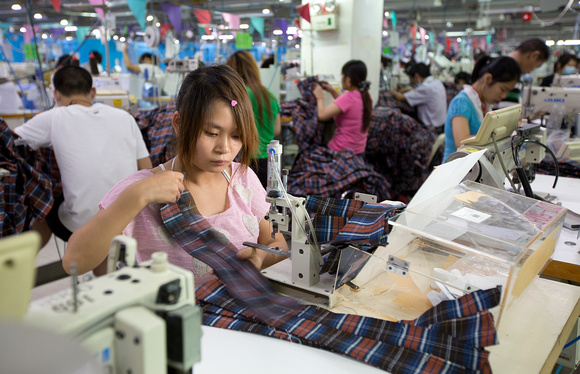FW
Government of Zimbabwe, in its mid-year fiscal policy review, has announced that the Government will make concerted efforts to boost the country’s textile sector. The move has come as blanket imports to Zimbabwe have plunged by 98 per cent, from $500,000 worth of products to $11,000 since the removal of the commodity (blankets) from the open general import license in July this year.
The government has also proposed to introduce ‘manufacturers’ rebate duty’ on critical inputs imported by approved textile manufacturers covering spare parts, yarns and unbleached fabrics, among others. The new measure forms part of extensive interventions that the government is taking to grow the economy.
Zimbabwe’s textile and leather industries, since ‘dollarisation’, have been under siege from the influx of imports, especially finished second hand clothes, shoes and leather products. All these have forced some of the domestic manufacturers to shut shop, so the Government of Zimbabwe decided to fast-track the gazetting of a Statutory Instrument that prohibits import of blankets.
Almost one hundred US congressmen from the cotton-growing states have appealed to the Obama administration for price support to help struggling farmers, with new subsidies since losing a trade case with Brazil last year.
The House of Representatives members signed a letter urging Secretary of Agriculture Tom Vilsack to allow cottonseed, a secondary product of the crop valued mainly for its fibre, to qualify for subsidies available to other oilseeds. The industry's support program was stopped in the 2014 Farm Bill after the United States settled a trade case with Brazil with promises that it would not give direct subsidies for fibre. But cottonseed, a by-product, can be made eligible.
Other crops such as soybeans are eligible for two U.S. Department of Agriculture programs which pay producers when their revenue from a commodity or that commodity's price falls below a certain level. The 2014 Farm Bill allows the USDA to designate crops as ‘other oilseeds’ for purposes of the Agricultural Risk Coverage (ARC) and Price Loss Coverage (PLC) programs, according to a copy of the letter posted on the NCC's website.
The industry would also circulate a similar letter to Vilsack for US senators from cotton belt states.
Many companies from Vietnam exporting to the US may not actually benefit being a part of the TPP since they import raw materials from non-TPP countries. For instance, according to the recent World Bank report on the TPP’s impacts on Vietnam, a large part of Vietnam’s current exports in the garment and textile industry would likely not comply with the TPP’s rule of origin (ROO) requirements.
Under the TPP’s ‘yard forward’ ROO, to benefit from a 0 per cent imported tariff rate, instead of the current 15-20 per cent, all manufacturing processes including yarn spinning, knitting and dyeing must be implemented in a TPP member country. The report states that, most imported yarn and fibre used by Vietnam’s garment producers are sourced from non-TPP territories, with Taiwan (32.6 per cent), China (27 per cent), South Korea (14.6 per cent), Thailand (10.5 per cent), and Indonesia (4.1 per cent). Materials imported from TPP member states occupy 5.3 per cent.
Meanwhile, under the EU-Vietnam Free Trade Agreement (EVFTA), the EU will eliminate duties within seven years for Vietnam’s textiles, apparel and footwear products, from the existing duty rate of 12.4 per cent. However, to benefit from the preferential access, this agreement’s strict ROO for garments require the use of fabrics produced in Vietnam. This would also mean that Vietnam will find it difficult to meet these EU strict ROO requirements.
On the other hand, according to the World Bank, ROO also creates opportunities for a slew of foreign firms to come to Vietnam to directly make textile, garment and footwear materials. For example, Hong Kong’s Texhong Textile and Garment Group has already committed a $300 million investment to set up a yarn plant in Quang Ninh province, where Hong Kong’s Black Peony is also developing a $100 million jean cloth producing factory.
www.worldbank.org
More than 7,000 garment workers were injured and 130 killed during traffic accidents that occurred while they were being transported to and from factories in the first 11 months of the year in Cambodia, according to a report from the National Social Security Fund (NSSF).
It registered almost 6,491 traffic accidents involving vehicles taking workers to and from garment factories from January 1 to November 30, 2015 and said 7,357 workers were injured in these accidents. The report also pointed out that 130 workers were killed and 1,068 were seriously injured in the accidents. On an average more than 10 garment workers were killed and about 90 injured every month while being transported to and from factories, the report said.
Drivers are the main cause of the accidents, the NSSF said, adding, speeding, breaking traffic laws, drunk driving, overtaking other vehicles and driving in the wrong lane are the main causes of the accidents. Traffic accidents, according to Pav Sina, President of the Collective Union of Movement of Workers, are a major concern of garment workers. He added that the drivers of trucks must be trained about traffic laws and higher quality vehicles should be used to transport workers to and from factories.
The International Labor Organisation’s Better Factories Cambodia program, which monitors all garment exporting factories for compliance with Cambodian labor law and international labour standards, does not include transport safety in its compliance checklist. However, according to the program manager, Esther Germans, safe transportation is an issue that must be addressed immediately.
Texcare International continues to expand. For the first time, Messe Frankfurt is opening Hall 9 in addition to Hall 8 for Texcare International 2016, to meet exhibitor demand for additional exhibition space, as well as to offer more space for new and young companies.
The inclusion of hall 9 offers improved presentation opportunities for exhibitors and, owing to the increase in the area covered and the number of exhibitors, the organisers expect the fair to be even more attractive to visitors.
Industry 4.0 will be a key factor at the coming fair. Intelligent networking of machines and product flows optimises processes, saves energy and changes the occupational profile. Many processes in modern industrial laundries and dry cleaners are already fully automatic. These processes can be further optimised by machinery and plant linked in ‘SmartFab’ terms and capable of exchanging information not only with each other but also with an enterprise resource planning system. For example, there could be an ‘intelligent wardrobe’ to regulate the laundry process at the customer’s.
Energy and resource efficiency continue to play a vital role in modern textile care. How can water, electricity and heat consumption be further reduced and intelligently controlled? In the textile-service field, sustainability is becoming a new quality feature along the entire value chain – from cotton growing to bed sheets in the hotel.
The demands on personal protective clothing and equipment are growing continuously. In addition to coatings, garments include sensors and electronic components that can, for example, warn of poisonous smoke or measure the wearer’s body temperature. Making highly complex functional clothing is a top subject at Texcare for manufacturers, research institutes and at the Texcare Forum.
www.texcare.messefrankfurt.com
The core topic discussed by a panel of researchers and scientists during the Sixth Open Session of the 74th Plenary Meeting of the International Cotton Advisory Committee (ICAC), a technical seminar was around the theme of ‘Elimination of Insecticides from Cotton Production: Is This Possible?’
While the boll weevil has historically been cotton's biggest archenemy, there are multiple secondary pests that continue to drive insecticide use, including the whitefly in Pakistan and India. This year, as much as two-third of the cotton crop in India's state of Punjab suffered damage from a whitefly outbreak. With so much at stake, the use – and sometimes overuse – of insecticides is understandable, as farmers do everything they can to protect their livelihood. Globally, more than $15 billion was spent on various insecticides in 2013.
“Fortunately, we don't necessarily need to completely eradicate the use of all insecticides to do a lot of good," says Francesca Mancini, a pest and pesticide specialist with the United Nations Food and Agriculture Organization (FAO), adding, “The elimination of HHPs [highly hazardous pesticides] from cotton production would contribute enormously to reducing risks to the environment and human health."
Many insect problems, the panellists agreed, aren't caused by the chemicals themselves, but rather by their improper use. Farmers who apply the wrong chemicals at the wrong time exacerbate the problem. Great strides could be made toward reducing the amount of insecticides used, and increasing their efficacy, through education of growers. One such approach, they said, is integrated pest management (IPM), which emphasizes the growth of a healthy crop with the least possible disruption to agro-ecosystems and encourages natural pest control mechanisms.
www.icac.org
On International Human Rights Day, labour network Clean Clothes Campaign (CCC) joins more than 25 countries in a global call on major brands such as H&M, GAP, Levi's and Inditex to make sure Cambodian workers receive $177 as a first step towards a living wage.
In addition, the organisations support the Cambodian union coalition to make sure a controversial Trade Union Law will not be passed before genuine and inclusive consultation with civil society and trade unions is guaranteed by the government of Cambodia.
Stores of H&M, Adidas and others will be targeted in street actions in the US, Europe and Asia. In Cambodia, thousands of workers from a coalition of eight unions will rally the streets in three provinces, wearing stickers saying: 'We need a living wage!”
In October, the Labour Advisory Council (LAC), a tripartite wage-setting body voted to approve a new minimum wage of $140, to be implemented in January 2016 for Cambodia’s 700,000 garment workers, despite objections from a number of unions. This insufficient $12 wage increase is a slap in the face to workers who have been organizing for over a year to demand a fair minimum wage of $177.
Cambodia recently saw another wave of mass fainting in garment factories. In August 2015, nearly 400 workers fainted in four factories across Cambodia. On July 2 alone, 38 workers lost consciousness in a factory in Phnom Penh. In 2014, the Ministry of Labor recorded that more than 1,800 workers collapsed in 24 factories. Mass fainting have been linked to malnutrition, high targets and long working hours, as a consequence of low wages and the need for workers to survive.
A coalition of Cambodian unions are joining together to demand that the brands immediately ensure a minimum wage of $177 is paid in their Cambodian suppliers and negotiate directly with Cambodian unions a binding agreement to achieve living wages, decent purchasing practices, stable employment, and union rights for the long-term. They also urged the government to refrain from passing the law until genuine consultation has taken place with independent unions.
Cleanclothes.org
Mexico and the US are major trade partners. Of late, Mexico’s economy is witnessing growth with its unemployment and debt constantly declining. Mexico’s geographic location between North and South America is beneficial for exports, which has made it the seventh largest export market in the world and the most important one in Latin America. The economy of Mexico is the 15th largest in the world in nominal terms and the 11th largest by purchasing power parity, as per the data provides by International Monetary Fund.
The Mexican textile industry has a long history of making fibers, cloth and other textile goods since at least 1400 BCE. The textile industry remains important to the economy of Mexico although it has suffered setback due to competition by cheaper goods produced in countries such as China, India and Vietnam. The proactive government policies of the country have also supported the industry in a big way. Mexico offers an ideal investment location for companies active in the clothing and textile sectors. It has a highly skilled and economically competitive workforce and excellent access to world-class inputs and technologies. Moreover, its geographical location and extended network of Free Trade Agreements (FTAs) make it a strategic hub from which to export to major markets in North and South America, the EU, EFTA and beyond.
While Mexico imports cotton products majorly from USA and India, textile and apparel goods manufactured in the United States enter Mexico duty free under the North American Free Trade Agreement (NAFTA).
According to a report by investment information and credit rating agency ICRA, India’s apparel exports are likely to increase to $18 billion in calendar year 2015 and to $20 billion 2016 against $16.5 billion in 2014. The growth in India’s apparel exports will be supported by its expectations of increase in the global apparel trade and partly due to benefits of depreciated rupee.
However, warning sign in the report say that “depreciated rupee is unlikely to remain as a sustainable advantage in long-term as India’s market share in world’s trade has not significantly changed despite depreciation of Indian Rupee during last three years. As per the report, China, Bangladesh, Italy, Germany, Vietnam and India will the top six apparel exporting countries.
Over the last decade, India’s share in global apparel exports has remained modest at 3 to 4 per cent despite being one of the world’s largest cotton producer and manufacturer of man-made fibres with world’s second largest spinning and weaving capacity. China, Bangladesh and Vietnam are able to realize the benefits of the new trade arrangement (WTO’s agreement on textile and clothing) and hence increasing their share in global apparel trade substantially.
According to the report, fragmented nature of the weaving, processing and garmenting industries with low levels of modernisation, higher cost of production, modest share of non-cotton apparel and reliance on imported machineries across the textile chain have been the key factors which had constrained growth in India’s apparel exports. Domestic apparel industry expected to maintain the growth rate witnessed in the past, driven by steady consumption demand growth. Apparel trade globally is expected to maintain the momentum in 2015 and 2016. However, apparel exports in India will increase along with global apparel trade, it said.
www.icra.in
"TAL example indicates at the larger picture in China where manufacturing anything from clothes to toys was considered extremely cheap once upon a time due to low wages and production costs. However, now with complicated government policies and the country’s quest to move to higher-value manufacturing, the situation is changing."

Production moving to South Asian countries

TAL has already started moving its pants production from China to Malaysia, where it has another factory, and it is also expanding base in Vietnam. However, TAL would continue to run its other factory in China making dress shirts since shirt making according to the company is more complex as well as more profitable than pants, because the fabric is thinner and puckers more easily.
TAL example indicates at the larger picture in China where manufacturing anything from clothes to toys was considered extremely cheap once upon a time due to low wages and production costs. However, now with complicated government policies and the country’s quest to move to higher-value manufacturing, the situation is changing. On one hand, Chinese government is following complete automation of its industries and has also unveiled a 10-year plan to put the nation at the forefront of technologies like 3-D printing and high-end machine tools, on the other, local governments are almost doubling the minimum wages forcing manufacturers to close factories. No wonder, companies like Coach Inc have moved their production to Southeast Asia.
Domestic manufacturers are combating rising production and labour costs in the textile and apparel industry, which has also led to China losing its status as the mass producer of goods. China’s costs have risen so quickly and to the extent that importing countries are moving to many other Southeast Asian countries such as Malaysia, the Philippines, Indonesia and Vietnam that offer low production and labour costs.
Losing status as manufacturing powerhouse
As Stanley Lau, Former chair of the Federation of Hong Kong Industries points out, the situation in China is only going to worsen. Federation of Hong Kong Industries is a trade group for 3,000 manufacturers, mostly with factories on mainland. He forecasts between 2014 and 2017, 10 per cent of mainland factories owned by Hong Kong-based manufacturers would close. The number of Guangdong factories owned by Hong Kong companies declined to 32,000 in 2013 from a 2006 peak, owing to again rising wages and difficulty in getting skilled workers, as per the analysis by Justina Yung of Hong Kong Polytechnic University for the federation.
This year, wages and benefits in China are expected to climb 8.6 per cent, lower than the previous year’s 10.3 per cent growth rate, according to the Economist Intelligence Unit. China’s average labour cost of $3.27 an hour in the manufacturing sector is two-thirds higher than Vietnam’s and a quarter above Malaysia’s.
Many leading western players turned to neighbouring markets like India, Bangladesh, Vietnam, Indonesia, and Cambodia after sourcing from China started becoming expensive. However, despite having sufficient capacities to cater to the needs of western players, India, Indonesia and Vietnam are facing constraints due to recent increase in minimum labour wages. So their attention is now moving to Malaysia, Myanmar and other such low cost destinations.












